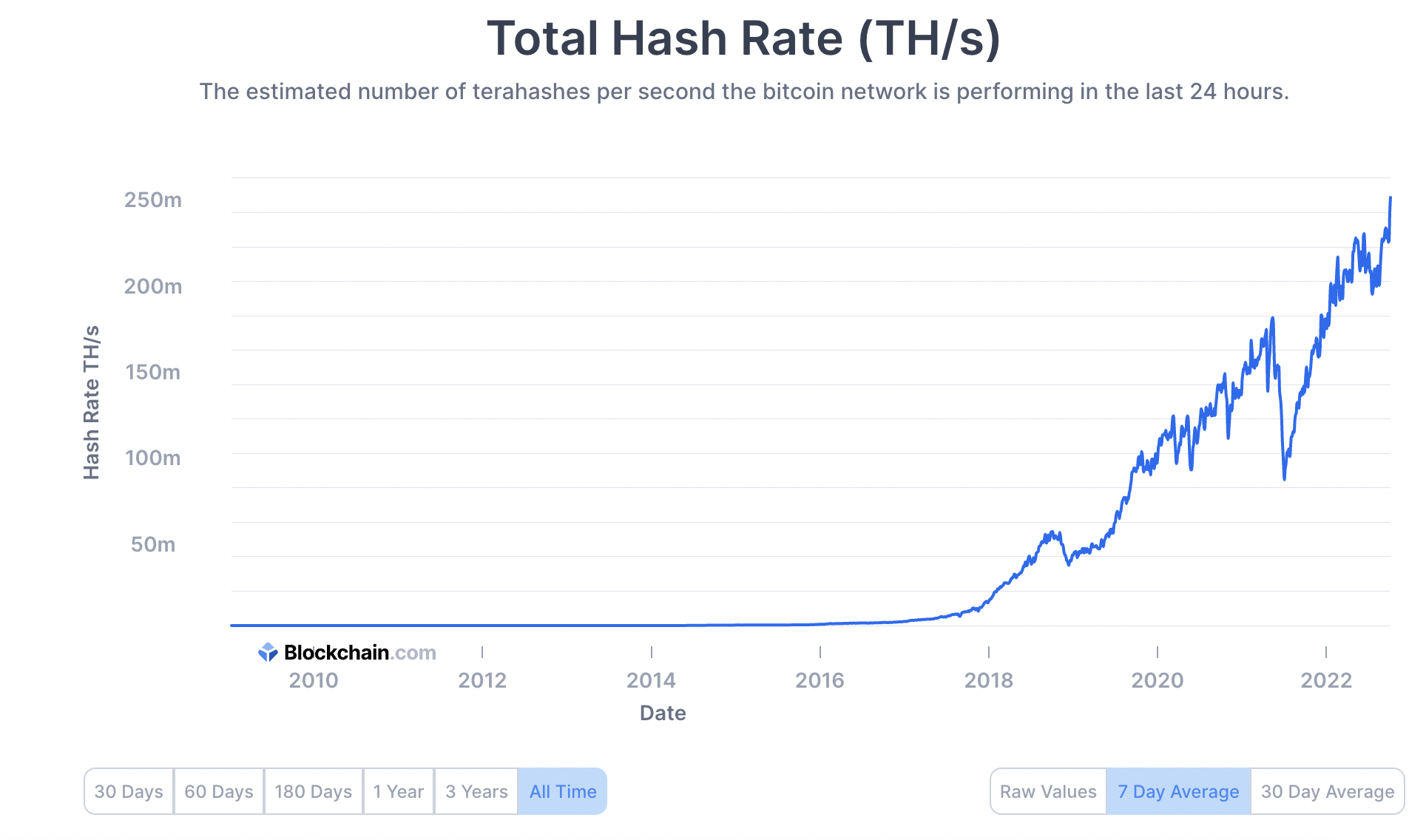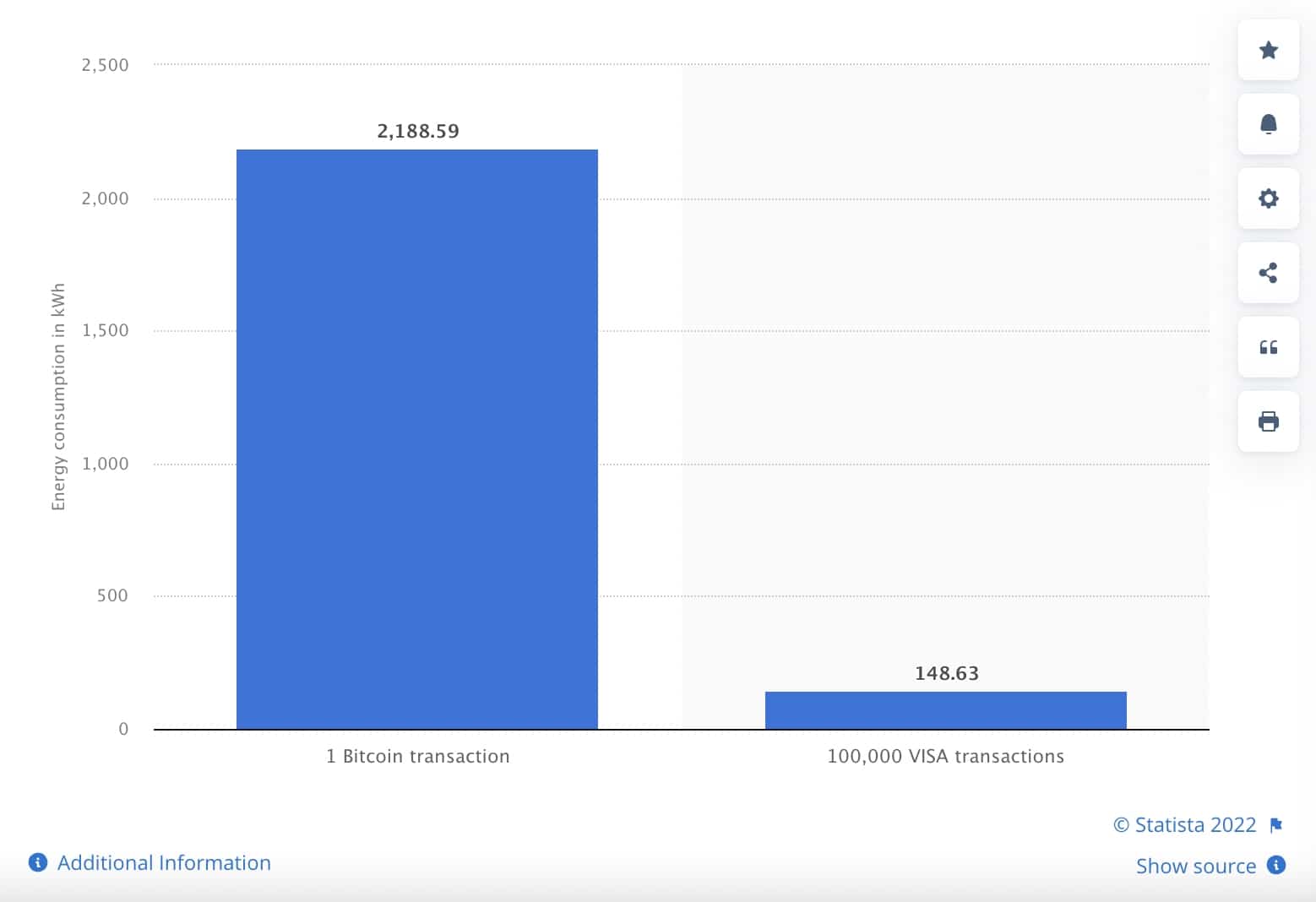The relationship between crypto and the environment is complex. On the one hand, Bitcoin was created with libertarian goals in mind, insofar as the technology provides a decentralized network to send, receive, and own digital currency without requiring a third-party intermediary.
However, as we discuss in more detail throughout this guide, Bitcoin consumes unprecedented levels of energy. This is because of the underlying mining of the proof-of-work consensus mechanism, which keeps Bitcoin decentralized and secure.
In its most basic form, Bitcoin miners are required to connect specialist hardware devices to a device, with the view of solving ultra-complex mathematical equations. This competitive nature means that the device to solve the equation first will be rewarded with a tranche of Bitcoin.

With that being said, Bitcoin isn’t the only blockchain network in this space. Take Ethereum for example. Since its much-anticipated Merge to a proof-of-stake model, a report commissioned by the Crypto Carbon Ratings Institute (CCRI) recently noted that it is now 99.99% more energy efficient.
This is one of the core reasons that energy-efficient cryptocurrency projects like IMPT are opting for the Ethereum blockchain. In contrast, Tesla CEO Elon Musk recently announced that the company would temporarily suspend accepting Bitcoin as a payment method, due to its status as an energy-inefficient network.
How Crypto Can be Bad for the Environment?
So now that we have covered the basics, in this section of our guide – we will look to fully answer the question – is crypto bad for the environment?
Proof-of-Work
To evaluate whether or not crypto is bad for the environment, it is important first to have a grasp of how blockchain transactions are verified.
- When Bitcoin was created in 2009, the digital currency opted for a consensus mechanism known as proof-of-work.
- This enables people to send and receive funds without needing to go through a third party, such as a bank. It also made Bitcoin the best PoW crypto on the market.
- And, to ensure that the Bitcoin network remains decentralized and free from centralized control, the proof-of-work mechanism requires ‘miners’ to verify transactions.
- Anyone can become a miner, so long as they have the required hardware devices.
- In the early days of Bitcoin – where competition was virtually non-existent, it was just a case of connecting a basic GPU to a desktop computer.
- However, fast forward to 2022 and Bitcoin is now a multi-billion dollar asset class.
As a result, to successfully mine Bitcoin for a chance of winning the block reward, significant resources are required. Not only in terms of a fully-fledged mining rig with perhaps hundreds of expensive, specialist hardware devices, but sizable consumption of electricity.
After all, not only do the mining devices require energy to function, but due to the complexities of the Bitcoin proof-of-work algorithm that must be solved, electricity usage is now off the scale.

Take the image above as a prime example of how bad Bitcoin currently is from an environmental perspective. The chart shows that in April 2022, 1 Bitcoin transaction consumed more than 2,188 kWh. In comparison, 100,000 Visa transactions required just 148 kWh.
In another example, it was recently reported in a Columbia Climate School journal that Bitcoin now consumes more electricity than the entire country of Argentina – which is home to a population of over 45 million people.
Closer Scrutiny on Crypto Energy Usage
Global energy prices are at unprecedented highs. This has resulted in much closer scrutiny of proof-of-work blockchain networks like Bitcoin.
But even before the current energy crisis, several governments around the world stepped in to regulate or outright ban Bitcoin mining.
China is the standout case here, with the country putting a ban on crypto-related mining operations in May 2021. Prior to the ban, China was by far the dominant force in the Bitcoin mining industry, due to its access to cheap energy.
However, China itself has recently experienced energy blackouts due to a vast increase in demand, and a reduction in domestic supply. Therefore, it is unlikely that the government will look to reverse its crypto mining ban any time soon.
The Cheapest Energy Supply is Required
While Bitcoin mining is no longer legal in China, leading players in this space have simply moved to other jurisdictions. More specifically, the overarching metric for mining firms to be successful is having access to the cheapest energy possible.
After all, Bitcoin mining is a profit-generating exercise, and energy is by far the largest cost basis during the process. Regrettably, the cheapest energy supplies utilized by mining companies are typically from fossil fuels, namely coal.
As this guide will discuss shortly, there are, however, mining organizations outside of the Bitcoin scene that operates exclusively on green energy supply from local sources.
Therefore, while in its current form mining can be detrimental to the environment, this isn’t the case across the broader crypto market.
How Crypto Can be Good for the Environment?
In this section of our guide, we will answer the question – ‘is crypto bad for the environment?’, from a different perspective.
More specifically, we will explore the positive metrics associated with crypto and blockchain technology.
Other Consensus Mechanisms
According to CoinMarketCap, there are over 21,000 crypto assets that can be traded in this industry. Of this figure, the data aggregation website notes that just 175 projects operate on the proof-of-stake consensus mechanism.
In addition to Bitcoin, some of the top trending coins on the proof-of-work network include Dogecoin, Litecoin, Ethereum Classic, Monero, and Bitcoin Cash.
Crucially, this means that the vast majority of the most searched-for crypto projects actually operate on more energy-efficient blockchains.
- For example, we briefly mentioned earlier that Ethereum has finally completed its much-anticipated migration to proof-of-stake.
- After a 6-year development process, this means that ETH – and the many thousands of ERC-20 tokens that operate on Ethereum, are now considered energy-efficient.
- Not only in terms of the amount of energy required to validate transactions, but Ethereum is now cheaper, faster, and more scalable.
The overarching reason for this is that Ethereum, one of the best proof-of-stake cryptos, no longer requires miners to compete for transactional throughout via complex mathematical equations. On the contrary, the proof-of-stake mechanism is considered a much fairer and subsequently energy-efficient system.
Carbon Offset Programs
One of the best ways that crypto and blockchain technology can help improve the environment is via carbon offset programs. This is something that traditionally, only large corporations have access to.
In its most basic form, many jurisdictions have a set limit on the amount of carbon emissions that a company can be responsible for over a 12-month period. If the company uses more than its allowance, it will need to
If it underutilized its allowance, it can sell its carbon credits to other companies. This is something that represents a viable revenue source for energy-efficient firms like Tesla.
Nonetheless, as we cover in more detail shortly, IMPT offers both companies and individuals the chance to offset their carbon emissions through blockchain technology and NFTs.
Blockchain-Based Solar Markets
Another way that crypto can help accelerate a global shift to renewable energies is via a peer-to-peer system that connects consumers.
For example, Australian company PowerLedger has created a blockchain-based portal that enables homeowners to sell excess energy that has been generated via solar panels. Those that require surplus energy can subsequently access their needs via the PowerLedger portal.
The idea here is that consumers not only have access to locally sourced, green energy – but in a cost-effective way. Regarding the latter, this is because the PowerLedger concept cuts out the middleman – meaning that there is no involvement from third-party energy firms.
Trackable Forestry Regeneration via the Blockchain Ledger
Another aspect to consider when researching the relationship between cryptocurrency and the environment is that blockchain technology could be a powerful source in forestry regeneration.
The long-term goal here is that each and every tree within a specific area can be added to a global blockchain ledger.
With each tree backed by a unique NFT, this would allow society to track proof of land and regrowing activities. For example, if a tree is cut down for paper and pulp purposes, the blockchain could transparently track whether or not a regrowing process has been initiated.
Large-cap project Cardano, for example, which many believe is one of the best long-term cryptocurrency investments for exposure to environmental solutions, reached its goal of planting 1 million trees earlier in 2022. The entire process has been recorded on the Cardano blockchain.
The Best Cryptos That Help the Environment
Many market commentators argue that the most sustainable cryptocurrencies are those that operate in conjunction with environmentally-friendly practices.
Therefore, in the sections below, we discuss the best altcoins in the market right now that actually help the environment.
- IMPT – Overall Best Crypto for the Environment with Access to Carbon Credits
- Algorand – Mid-Cap Crypto Project That is Carbon-Negative
- Copium Protocol – NZ-Based Mining Firm Operating 100% on Green Energy
- Cardano – PoS Blockchain With a Focus on Environmentally-Friendly Initiatives
- Power Ledger – Peer-to-Peer Solar Energy Market on the Blockchain
Read on to learn more about the above energy-efficient projects.
1. IMPT – Overall Best Crypto for the Environment
Investors looking for the most sustainable cryptos to invest in might consider exploring IMPT. In a nutshell, IMPT is a carbon-neutral platform built on the Ethereum blockchain.
The IMPT ecosystem includes a carbon marketplace, and a shopping and social platform. The platform can be used by organizations as well as individuals that are conscious of their effect on the environment.
Put simply, IMPT offers each user a variety of ways to earn and buy carbon credits. The platform offers rewards and points that users can earn for having a positive impact on the environment.
Users are able to offset their carbon footprint as they shop thanks to the 10,000+retailers and brands that have collaborated with IMPT. Moreover, shops can be chosen by consumers depending on how well they cut CO2 emissions.
The IMPT token that users accumulate can be used to buy carbon credits. Importantly, holders will be given a carbon credit NFT as soon as they have accrued the necessary amount of tokens.
Users will also be rewarded for retiring their carbon credits in this project. This offers a truly transparent way of offsetting our carbon emission footprint.
The IMPT platform also offers access to hundreds of environmental initiatives. IMPT will eventually introduce its own score system and various rating levels. The end goal is to enable individuals and businesses to more accurately assess and work on their impact on the planet.
This innovative project has just initiated its presale campaign, which enables investors to buy IMPT tokens at the best price possible.
The first tranche of tokens are selling at the equivalent of $0.018 each. This price will increase to $0.023 once the first tranche of tokens is sold, or on December 1st, 2022 – whichever comes first. As a result, this offers an immediate upside of over 27%.
All in all, IMPT could be one of the best future cryptocurrency projects to keep an eye on.
| Chain | Ethereum |
| Standard | ERC-20 |
| Token Price | $0.0180 |
| End Date | 1st December 2022 (Stage 1) |
| Vesting | Unlock Token Generation Event |
| Team | Denis Creighton (CEO), Mike English (CTO), Hugh Phelan (CLO) |
Investors that are interested in this project are advised to read the IMPT whitepaper before proceeding. The IMPT Telegram channel can also be joined to receive real-time upsides on the presale campaign.
2. Algorand – Mid-Cap Crypto Project That is Carbon-Negative
Algorand is a mid-cap blockchain network that was created in 2019. Backed by the ALGO token, this project is dedicated to providing a framework for decentralized payments that are cheap, fast, scalable, and most pertinently for this analysis – environmentally sustainable.
Through its proof-of-stake protocol (PPoS), each transaction facilitated by the Algorand blockchain utilizes just 0.0000004 kg of CO2 on average. Algorand notes that in comparison, Bitcoin requires 338 tons of CO2.
Not only that, but Algorand claims to offset its carbon usage by purchasing credits in the open market. And therefore, this makes Algorand a carbon-negative blockchain. Those with an interest in the long-term environmentally-driven goals of Algorand can gain exposure to the project by purchasing the ALGO token.
In fact, at the time of writing this guide, ALGO is trading at significant discounts when compared to the all-time of $2.83 that it achieved during the prior crypto bull market. Based on current prices, investors can buy ALGO at 85% below its prior peak.
Crypto assets are a highly volatile investment product. Your capital is at risk.
3. Copium Protocol – NZ-Based Mining Firm Operating 100% on Green Energy
While mining is often regarded as being the biggest issue for the relationship between crypto and the environment, this isn’t the case with Copium Protocol. In a nutshell, Copium Protocol is a New Zealand-based crypto mining firm that operates 100% on green energy.
All of the energy utilized by the mining firm is not only renewable, but locally sourced. As a result, this highlights that when the right framework is in place, crypto mining can be sustainable. To take its mining operation to the very next level, Copium Protocol is opening its doors to outside investors.

The firm is raising funds to achieve its long-term sustainability goals in two key ways. First, Copium Protocol is running a presale campaign, where early investors can purchase the Copium Coin. The presale supply will amount to just 50 million Copium Coins, at an initial price of 18,519 tokens per ETH as of writing.
The second option available is to purchase a Copium Protocol Investor Pass, which is represented by an NFT on the Ethereum blockchain. Just 10,000 NFTs will be made available to investors and holders will have access to a multitude of perks. This includes being eligible for a crypto airdrop of 10,000 Copium Coins, in addition to high-yield staking interest rates.
Read our full Copium Protocol review here.
4. Cardano – PoS Blockchain With a Focus on Environmentally-Friendly Initiatives
Cardano is a blockchain project that was launched in 2017. It operates on a proof-of-stake consensus mechanism, which as discussed earlier, is significantly more environmentally-friendly than the proof-of-work model employed by Bitcoin Dogecoin, Litecoin, and others.
This digital currency is now one of the most valuable in this space, with Cardano carrying a market capitalization of nearly $15 billion as of writing. With that being said, Cardano is more than just a proof-of-stake crypto asset, with the project involved in various initiatives to help the environment.
This includes the previously discussed tree planting project. As noted earlier, Cardano was successful in planting 1 million new trees – each of which is publically verifiable and trackable on the blockchain network.

In terms of its value, the ADA token – which backs the Cardano ecosystem, was priced at just $0.026 in 2017 – as per data extracted from CoinMarketCap. ADA hit an all-time high of $2.38 in late 2021, which represents overall growth of 9,000%.
However, owing to the broader bear market, as of writing, those electing to buy Cardano can do so at a huge discount of 81%, when compared to its all-time high of $2.38.
Crypto assets are a highly volatile investment product. Your capital is at risk.
5. Power Ledger – Peer-to-Peer Solar Energy Market on the Blockchain
Founded in 2017, the Australian crypto startup Power Ledger has developed an innovative peer-to-peer system that enables consumers to buy and sell renewable energy. The concept is that those with solar panels at home can connect to the Power Ledger network and sell any surplus energy generation.
Those local to the network can subsequently purchase the excess solar energy, without needing to go through a third party. Not only does this keep energy transactions on a peer-to-peer basis, but it promotes the usage of locally sourced green energy.

Power Ledger – which operates on the Ethereum blockchain, is backed by the POWR token. This ERC-20 token carries a market capitalization of just $95 million as of writing, which offers an attractive upside for long-term value investors. As such, POWR is one of the best low-cap crypto projects in the sustainable blockchain space.
The Verdict – Can Crypto Help the Environment & Fight Climate Change?
In summary, the broader crypto and blockchain technology is still in its infancy. As such, although legacy networks like Bitcoin are deferential to the environment, there are plenty of innovative projects that actually improve sustainable practices.
IMPT, for example, is a newly launched project that enables both consumers and businesses to offset their carbon emissions. Moreover, IMPT supports carbon credit trading via NFTs that are recorded on the Ethereum blockchain.
IMPT is opening its doors to the general public via a crypto presale launch – which offers preferential prices to early investors.








No comments:
Post a Comment